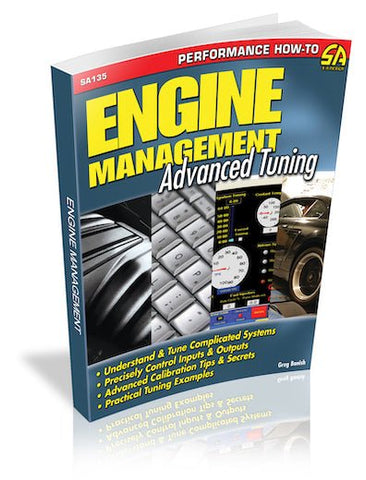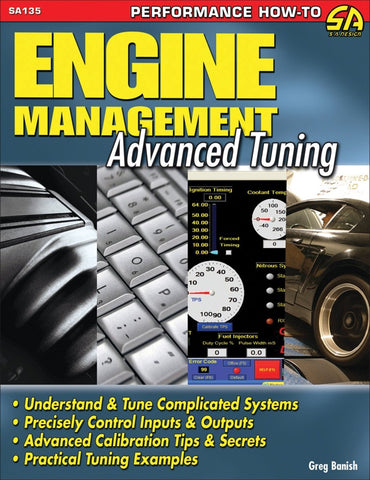This book explains how the EFI system determines engine operation and how the calibrator can change the controlling parameters to optimize actual engine performance. Engine Management: Advanced Tuning takes engine-tuning techniques to the next level. It is a must-have for tuners and calibrators and a valuable resource for anyone who wants to make horsepower with a fuel-injected, electronically controlled engine.
Author Greg Banish is a calibration engineer with extensive aftermarket performance calibration experience. He has a BSME from GMI Engineering and Management Institute (Kettering University). With over a thousand unique calibrations performed over five years, he has worked with enthusiasts and OEMs alike to improve the performance and driving behavior of a wide range of vehicles.
The book contains detailed equations, graphs, and illustrations. Also included are valuable and practical examples, including real-world examples based upon the author's experience that will help more advanced readers apply this new information to situations that are commonly seen during calibration.
Acknowledgments
About the Author
Chapter 1: Introduction
Chapter 2: The Basics
4 Cycles of an Engine
Air and Fuel
Chapter 3: The Goold Ol’ Days
Carburetion
Timing
Cam Timing
Chapter 4: Taking Measure
Throttle Position
Coolant Temperature
Air-Inlet Temperature
Manifold-Surface Temperature
Mass Air Flow
Manifold Pressure
Barometric Pressure
Crank/Cam Position
Rail Pressure
System Voltage
Oxygen Sensors
Knock Sensors
Chapter 5: Outputs
Fuel Injectors
Ignition
Fuel Pump
Throttle/ETC/Fly by Wire
Idle Air Control
Runner Controls
Cam Controls
Boost Control
Chapter 6: “The Recipe”
Modeling Airflow
Mass Air Flow
Speed Density
Fuel Delivery
Picking a Ratio
Transients and Modifiers
Correction Factors
Chapter 7: Ignition
Burn Rate
“Blancing the Players”
Chapter 8: Data Logging
Know Your Load
Chapter 9: Getting into the Zip Code
Mass Air Flow Modeling
MAF Scaling
Speed Density Airflow Modeling
Spark Advance
Chapter 10: Settling Down
Dashpot
Chapter 11: More Power
Chapter 12: Polising a Sculpture
Integrating Fuel Maps
Integrating Spark maps
Tip-In Ignition
Deceleration
Closing the Loop (or not?)
Choosing Cam/Runner Timing
Choosing a Shift Point
Almost Done
Chapter 13: Forced Induction
Centrifugal Superchargers
Positive Displacement Superchargers
Turbochargers
Nitrous Oxide
Chapter 14: Conclusion
Appendix A: Ford Tuning
Examples
Appendix B: GM Tuning
Examples
Appendix C: Standalone EFI Systems
Accel DFI
F.A.S.T.
AEM
MegaSquirt
Electromotive TEC3r
Appendix D: INCA OEM Calibration Tool
Appendix E: External Controllers
Electronic Ignition Boxes
VAFC/MAF Adjusters
Piggyback Controllers
Auxiliary Injector Control
Hobbs Switches
Mechanical Adjustable Fuel Pressure Regulators
The FMU
Manual Boost Controllers and Wastegates
Exhaust Cutouts
This book explains how the EFI system determines engine operation and how the calibrator can change the controlling parameters to optimize actual engine performance. Engine Management: Advanced Tuning takes engine-tuning techniques to the next level. It is a must-have for tuners and calibrators and a valuable resource for anyone who wants to make horsepower with a fuel-injected, electronically controlled engine.
Author Greg Banish is a calibration engineer with extensive aftermarket performance calibration experience. He has a BSME from GMI Engineering and Management Institute (Kettering University). With over a thousand unique calibrations performed over five years, he has worked with enthusiasts and OEMs alike to improve the performance and driving behavior of a wide range of vehicles.
The book contains detailed equations, graphs, and illustrations. Also included are valuable and practical examples, including real-world examples based upon the author's experience that will help more advanced readers apply this new information to situations that are commonly seen during calibration.
Acknowledgments
About the Author
Chapter 1: Introduction
Chapter 2: The Basics
4 Cycles of an Engine
Air and Fuel
Chapter 3: The Goold Ol’ Days
Carburetion
Timing
Cam Timing
Chapter 4: Taking Measure
Throttle Position
Coolant Temperature
Air-Inlet Temperature
Manifold-Surface Temperature
Mass Air Flow
Manifold Pressure
Barometric Pressure
Crank/Cam Position
Rail Pressure
System Voltage
Oxygen Sensors
Knock Sensors
Chapter 5: Outputs
Fuel Injectors
Ignition
Fuel Pump
Throttle/ETC/Fly by Wire
Idle Air Control
Runner Controls
Cam Controls
Boost Control
Chapter 6: “The Recipe”
Modeling Airflow
Mass Air Flow
Speed Density
Fuel Delivery
Picking a Ratio
Transients and Modifiers
Correction Factors
Chapter 7: Ignition
Burn Rate
“Blancing the Players”
Chapter 8: Data Logging
Know Your Load
Chapter 9: Getting into the Zip Code
Mass Air Flow Modeling
MAF Scaling
Speed Density Airflow Modeling
Spark Advance
Chapter 10: Settling Down
Dashpot
Chapter 11: More Power
Chapter 12: Polising a Sculpture
Integrating Fuel Maps
Integrating Spark maps
Tip-In Ignition
Deceleration
Closing the Loop (or not?)
Choosing Cam/Runner Timing
Choosing a Shift Point
Almost Done
Chapter 13: Forced Induction
Centrifugal Superchargers
Positive Displacement Superchargers
Turbochargers
Nitrous Oxide
Chapter 14: Conclusion
Appendix A: Ford Tuning
Examples
Appendix B: GM Tuning
Examples
Appendix C: Standalone EFI Systems
Accel DFI
F.A.S.T.
AEM
MegaSquirt
Electromotive TEC3r
Appendix D: INCA OEM Calibration Tool
Appendix E: External Controllers
Electronic Ignition Boxes
VAFC/MAF Adjusters
Piggyback Controllers
Auxiliary Injector Control
Hobbs Switches
Mechanical Adjustable Fuel Pressure Regulators
The FMU
Manual Boost Controllers and Wastegates
Exhaust Cutouts










